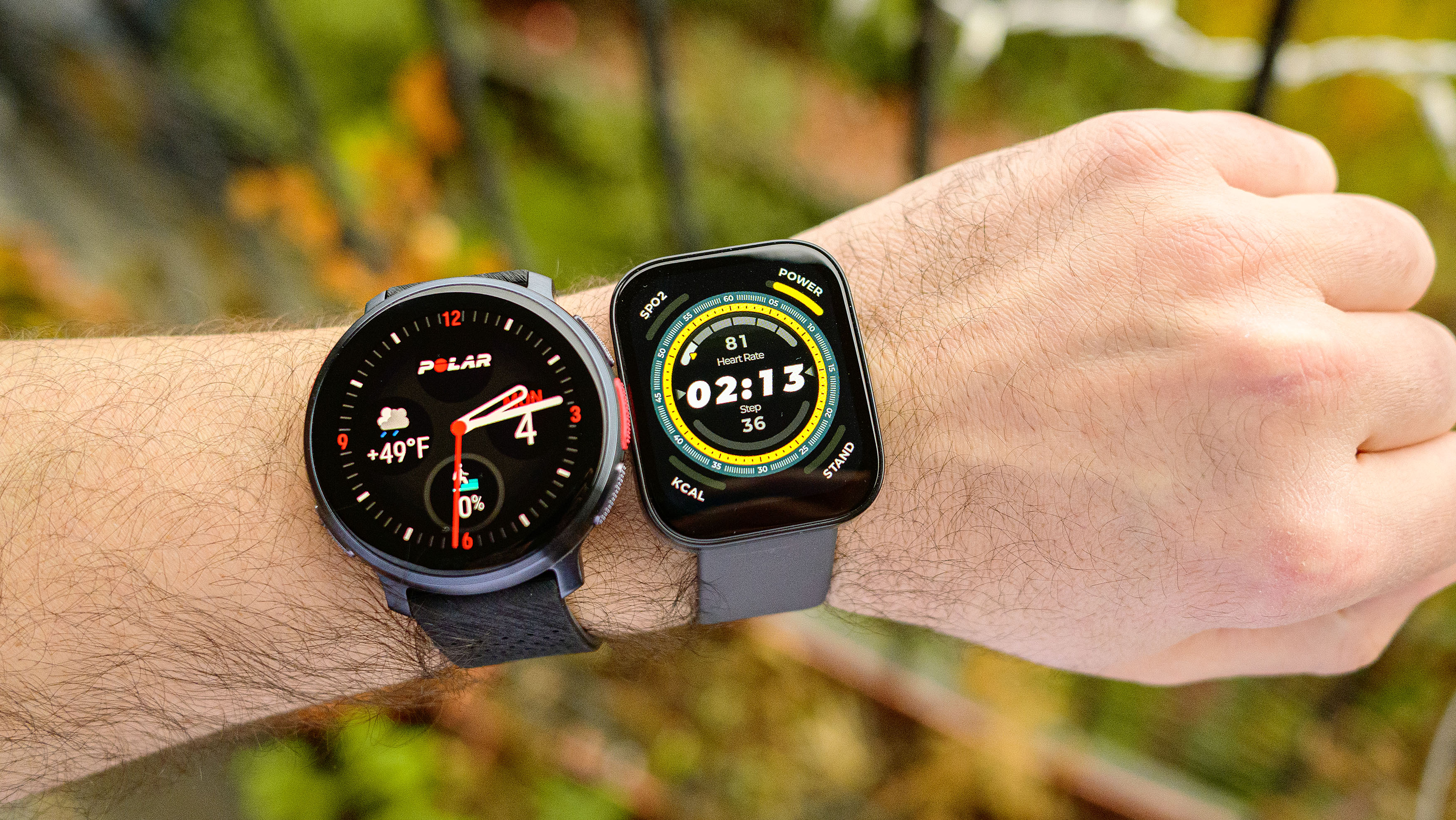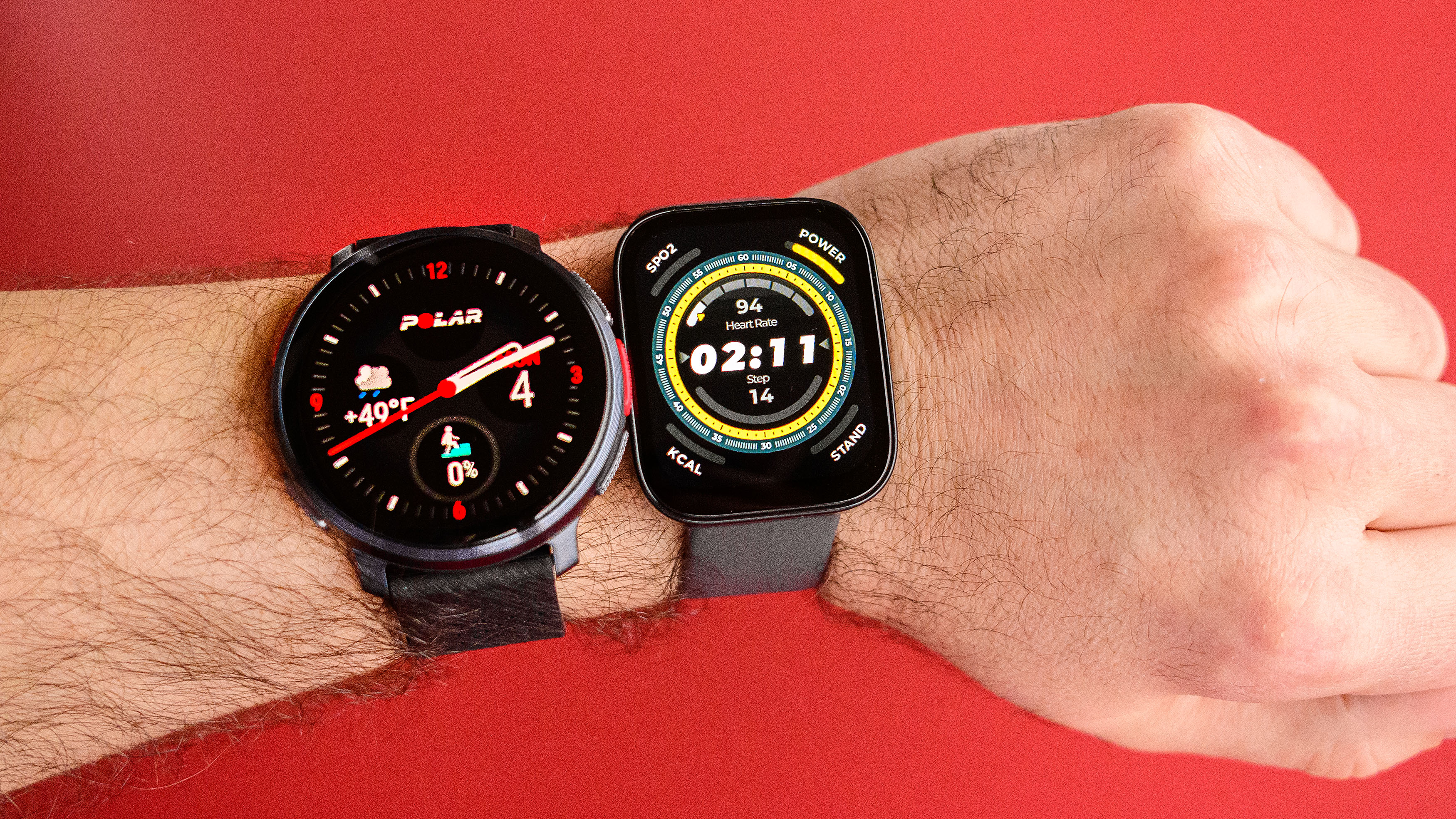I walked 5,000 steps with the $600 Polar Vantage V3 and $80 Amazfit Bip 5 — and this was more accurate

We're all about pitting the latest fitness wearable technology against each other. And this time around, we have a battle for the ages: A budget tracker, the Amazfit Inspire 3, takes on a fancy flagship, the Polar Vantage V3.
So what sets the two apart beyond one being $80 and a square and the other $600 and a circle? The Bip 5 is marketed more to casual users looking to keep tabs on physical activities and overall well-being. Unlike the Polar, it also offers smartwatch-like niceties such as Bluetooth calling and Amazon Alexa.
The Vantage V3 is geared more toward serious athletes, especially runners. And it offers an impressive suite of training and recovery tools in addition to fitness tracking ones.
But the two have more in common than not. Both devices sport onboard GPS, large touchscreens, physical buttons and the ability to track a wide range of physical activities, sleep and stress.
With the Bip 5 already notching a win against the Fitbit Inspire 3 in another recent step count showdown, I was curious to see if it could also hold its own against a much pricier device.
So, how did the Bip fair? Read on.
Polar Vantage V3 vs. Amazfit Bip 5 — step accuracy test
To find out which tracker more accurately counts steps, I put on a pair of waterproof boots and my finest Patagonia waterproof jacket and headed out into the brisk, moist Seattle night. My goal: walk (and manually count) 5000 steps.
Get instant access to breaking news, the hottest reviews, great deals and helpful tips.
With the Bip 5 on my left wrist, the Vantage V3 on my right and an old-fashioned tally counter in my pocket — tallied once for every 100 steps — I began my test. For good measure, I also ran Strava from my phone for an additional data point (which tends to be quite accurate).
Check out the results below.
| Header Cell - Column 0 | Polar Vantage V3 | Amazfit Bip 5 | Control |
|---|---|---|---|
| Steps | 4952 steps | 5,038 steps | 5000 steps (counted manually) |
| Distance | 2.48 miles | 2.52 miles | 2.57 miles (Strava) |
| Calories | 470 calories | 492 calories | n/a |
| Heart rate (average) | 115 bpm | 128 bpm | n/a |
| Pace (average) | 21 minutes, 28 seconds per mile | 20 minutes, 58 seconds per mile | 20 minutes, 38 seconds per mile (Strava) |
Both the Polar and Amazfit were within 50 steps of my actual total. But the Bip 5 was ten steps closer to 5000. Strava separately recorded 5038 steps, or ten steps fewer than Bip's 5048 count.
Also worth noting: The Amazfit app provided a total step count at the end of my walk. The Polar app did not — you only get an end-of-day total. Frustratingly, I ran into similar issues when testing the G-Shock DWH5600 fitness watch against the Inspire 3. Casio and Polar, the people want individual step counts for their walks!
This meant I had to calculate the steps for my walk by multiplying the average number of steps per minute recorded, 93, by the total recorded walking time, 53 minutes and 15 seconds, for a total of 4952 steps. Had the V3 provided an individual count, it's entirely possible it would've won. But c'est la vie.
Both devices also recorded similar total distances and calories burned. But the Bip's average heart rate of 128 bpm seems quite high. I also noted this in our head-to-head against the Inspire 3. Nevertheless, does this mean the Bip is a better tracking device than the Polar? Not necessarily.
The Polar provided more information about my walk than the Amazfit, including ascent (260 feet), descent (40 feet) and elevation (470 feet). The V3 also offered a more detailed breakdown of my calories burned, including calories from carbs vs. protein vs. fat. Plus, you get tips for post-work rest and recovery. Hilariously, for my walk, the V3 simply congratulated me on my "light exercise" rather than providing recovery tips.
Conclusion — Amazfit Bip 5 ekes out the win

The Amazfit Bip 5 wins the step count competition by a hair over the Polar Vantage V3. But both devices tracked my steps with excellent accuracy (within 50 steps of my real total). And Vantage provides more in-depth post-workout stats.
Of course, being accurate is only one important aspect of a good wearable. The best fitness trackers paint a vivid picture of your overall health and wellness. So, while the Bip wins this very specific battle, that doesn't necessarily make it the better device. On the other hand, the fact the Amazfit Bip can hold its own against a tracker that costs 7.5x more is quite impressive.
Stay tuned for our complete reviews on both.
More from Tom's Guide
- Polar Vantage V3 — 5 things that surprised me about this premium smartwatch
- 5 ways Casio can improve the G-Shock Move smartwatch
- I walked 2,800 steps with the Fitbit Inspire 3 and Amazfit Bip 5 — this one was more accurate

Dan Bracaglia is the Tom’s Guide editorial lead for all things smartwatches, fitness trackers and outdoor gear. With 15 years of experience as a consumer technology journalist testing everything from Oura Rings to instant cameras, Dan is deeply passionate about helping readers save money and make informed purchasing decisions. In the past year alone, Dan has assessed major product releases from the likes of Apple, Garmin, Google, Samsung, Polar and many others.
An avid outdoor adventurer, Dan is based in the U.S. Pacific Northwest where he takes advantage of the beautiful surroundings every chance he gets. A lover of kayaking, hiking, swimming, biking, snowboarding and exploring, he also makes every effort to combine his day job with his passions. When not assessing the sleep tracking and heart rate accuracy of the latest tach gadgets, you can find him photographing Seattle’s vibrant underground music community.
